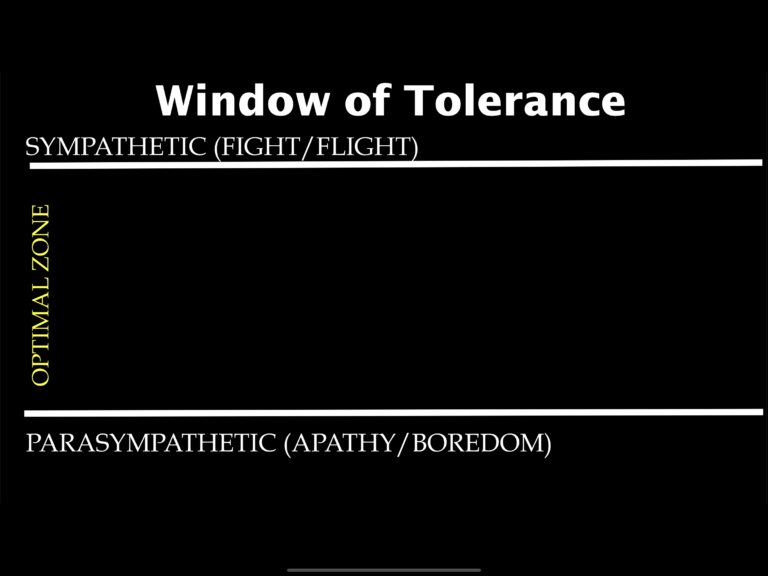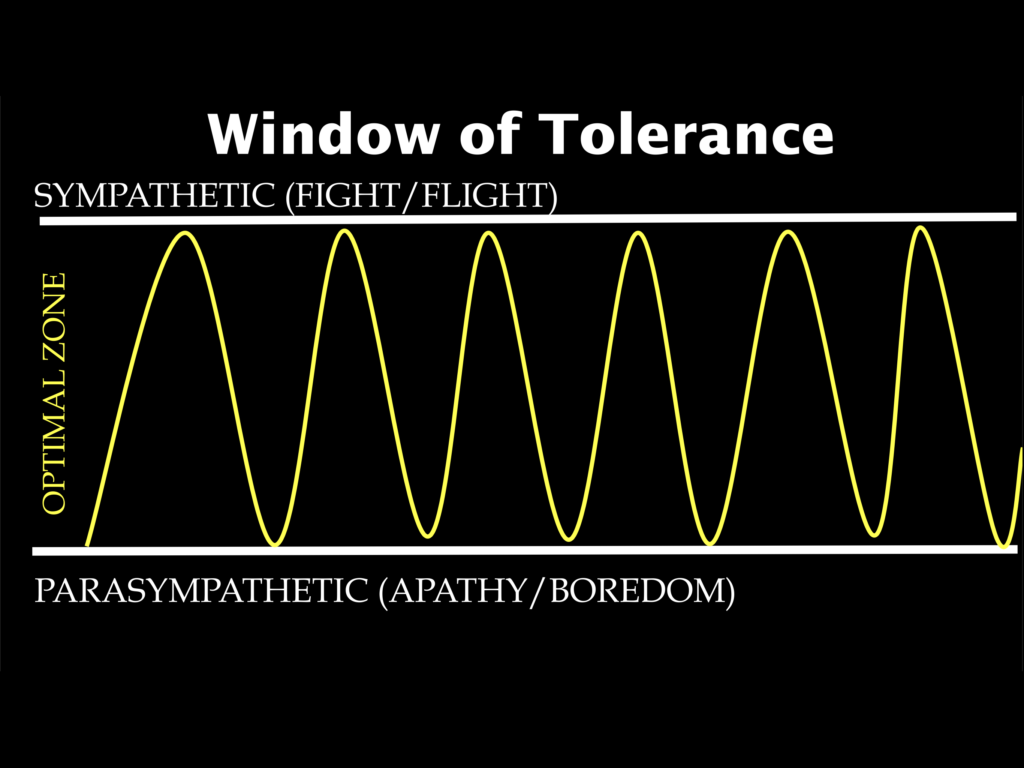Firefighter Window of Tolerance
Underneath the endless hours of training, prepping, planning there is a game being played that many firefighters have no idea is happening. This game is high stakes and can spell disaster for a career or allow you to leave happy, healthy, and mentally intact. This game doesn’t care about your ego, your self fulfilling bravado, or even about what you believe to be true. The game however controls your actions, your resilience to all stress and your mental toughness as a firefighter.
So, what is the game behind the scenes? It’s called your “Window of Tolerance” and you can tap into it to be the best version of yourself possible; both on the fire scene and off the job.
In this series of blog posts we’re going to dive into the Window of Tolerance, explore the parts and pieces of it and give you simple and tangible training tools to make your window as big as possible. The good news is training your window can be simple, is absolutely attainable, and you can even pass this information on to your crew to help build your team’s ability and ensure everyone is ready for the fireground.
Parts of the Window of Tolerance
The Window of Tolerance is made up of three parts. As you can see in the image below there are two horizontal lines and a space in between them. The top line represents the Sympathetic Nervous System (SNS). The bottom line represents the Parasympathetic Nervous System (PNS). In between the lines is commonly referred to as “coherence” and this is where we want to live. It’s within the two lines that optimal performance lives. It’s where we are at the peak of our mental toughness and are the most resilient to all the stressors we face. Both on and off the job.

Sometimes our window of tolerance shrinks and our two horizontal lines get closer together. Long term stressors such as sleep deprivation, poor breathing habits, and poor nutrition are just a few examples of things that can start to collapse our window. If we have a traumatic call that leads to PTS or PTSD this can also rapidly shrink our Window and put us over the Sympathetic Line or under the Parasympathetic Line for what might seem like eternity. When we go over the SNS line, we are in a hyper vigilant state. Parts of our brain actually shut off and we revert back to primal instincts that are tied to survival. Think about your last high stress call. It could be a fire or a cardiac arrest or something else. Did you feel like your brain was working 100% or was it foggy, with large time gaps, that maybe you still can’t recall what happened? If it’s the latter then you were above the SNS line at points in the call. Don’t worry however. This is a completely natural thing and you’re on the path to increasing your resilience to a whole new level simply by assessing how you responded to the stress.
If we fall below the PNS line, we can experience severe levels of apathy, or long term seemingly endless depression. Sometimes our Window of Tolerance is so tightly packed together that we can have rapid mood swings that go from high SNS arousal and drop to low PNS levels very quickly. This is a simplified version of what might happen to a bi-polar patient. Think about one of the 0300 runs during your career. One of those responses for the same patient you had already seen 2 times that day. What was your or the senior member of your crew’s attitude during the response? Was there some negative chatter in your head or in the rig? We’ve all been there and have had to intentionally work hard to be nice, provide solid customer service, and hopefully get back to quarters for a few solid hours of sleep. This is one example of being at or below the PNS line within the Window of Tolerance.
Awareness of Your Window
The first goal of almost all components of firefighter mental toughness is awareness. Awareness is especially key as we dive into our Window of Tolerance and figure out on a day to day assessment where we are at within our Window. This is foundational to build from as we analyze how to increase the gap between the SNS and PNS lines, and how to efficiently and effectively stay within our Optimal Performance Zone. Some days your Window is going to be wide open. Other days your Window is going to be almost slammed all the way shut. Have some patience, some grace, and know that with time, consistent practice, and a solid amount of diligent intentional work, you can increase your personal Window, keep it there and be ready for whatever this job or life throws your way.
Optimal Zone
From the image below we can see the yellow line demonstrating our response to stressors throughout an event or even a day. Sometimes we trend to more of a SNS Fight or Flight reaction and sometimes we trend more towards a PNS Apathy and Boredom reaction. We want to try and match the level of engagement or amplitude to whatever action we are performing. Some actions require us to be a little more amped up and aggressive mentally. Some actions require us to be more mellow and patient mentally. Think forcible entry on a drop bar door vs picking up Ms Smith who has fallen and cannot get up but has no injuries other than weakness.

Matching the correct mental state with the correct task at hand typically comes naturally to us. Sometimes, unfortunately, we bring a little too much to the party and take our stressors out on the ones we love. Have you ever lost your temper as you’ve helped a child with their math homework? How about while having a conversation about who was going to empty the dishwasher? This concept is not limited to fireground actions and sometimes is all the more prevalent to see when we’re off the job. The first step is being aware if you’re trending too much towards either the Sympathetic or Parasympathetic line.
In the following posts we’ll give you tangible tools to help either down regulate or up regulate to accomplish optimal performance and stay within your zone. We’ll also provide easy to implement ways to increase the size of the gap between the SNS and PNS systems which will allow you to consistently perform at a very high level on the job, off the job, for many years to come. Remember please seek out professional help in the event that this job or something you’ve experienced along the way is too much to handle. If an experience is always on your brain and you just can’t shake it please reach out to your peer support team, a professional mental health professional or even the fine and amazingly helpful people at Next Rung. We need you in this world whether you are a firefighter or not. The goal is to finish this career happy & healthy on the job and happy & healthy off the job and there is no shame in speaking with a professional to accomplish these goals.
Next up let’s unpack the sympathetic nervous system & specific ways to train it.






